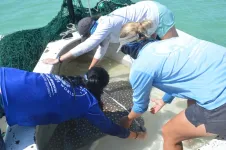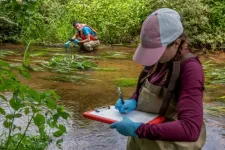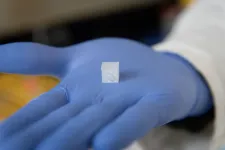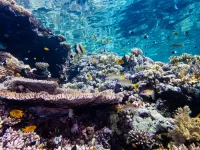(Press-News.org) Asbestos materials were once widely used in homes, buildings, automobile brakes and many other built materials due to their strength and resistance to heat and fire, as well as to their low electrical conductivity. Unfortunately, asbestos exposure through inhalation of small fiber particles has been shown to be highly carcinogenic.
Now, for the first time, researchers from the University of Pennsylvania have shown that extremophilic bacteria from high temperature marine environments can be used to reduce asbestos’ toxicity. The research is published in Applied and Environmental Microbiology, a journal of the American Society for Microbiology.
Much of their research has focused on use of the thermophilic bacterium Deferrisoma palaeochoriense to remove iron from asbestos minerals through anaerobic respiration of that iron. “Iron has been identified as a major component driving the toxicity of asbestos minerals and its removal from asbestos minerals has been shown to decrease their toxic properties,” said Ileana Pérez-Rodríguez, Ph.D., Assistant Professor of Earth and Environmental Science at the University of Pennsylvania.
D. palaeochoriense has also been shown to mediate transfer of electrical charge within the iron contained in asbestos, without changing its mineral structure. Doing so might enhance asbestos’ electrical conductivity, said Pérez-Rodríguez.
Based on this observation, the bacterium could be used to treat asbestos’ toxicity through iron removal. Alternatively, the new properties of electrical conductivity could enable reuse of treated asbestos for that purpose.
As with iron, the fibrous silicate structures of asbestos are also carcinogenic. Removal of silicon and magnesium from asbestos has been shown to disrupt its fibrous structure. The investigators tested the ability of the thermophilic bacterium Thermovibrio ammonificans to remove these elements from asbestos minerals by accumulating silicon in its biomass in a process known as biosilicification.
T. ammonificans accumulated silicon in its biomass when in the presence of “serpentine” asbestos, which has curly fibers, but not while growing in the presence of “amphibole” asbestos, which has straight fibers, said Pérez-Rodríguez. This difference, along with the varying amounts and types of elements released during microbe-mineral interactions with different types of asbestos “highlights the difficulty of approaching asbestos treatments as a one-size-fits-all solution, given the unique chemical compositions and crystal structures associated with each asbestos mineral,” Pérez-Rodríguez said.
Overall, these experiments promoted the removal of iron, silicon and/or magnesium for the detoxification of asbestos in a superior manner as compared to other biologically mediated detoxification of asbestos, such as via fungi, said Pérez-Rodríguez. However, further analysis will be required to optimize asbestos treatments to determine the most practical methods for the detoxification and/or reuse of asbestos as secondary raw materials.
###
The American Society for Microbiology is one of the largest professional societies dedicated to the life sciences and is composed of 30,000 scientists and health practitioners. ASM's mission is to promote and advance the microbial sciences.
ASM advances the microbial sciences through conferences, publications, certifications, educational opportunities and advocacy efforts. It enhances laboratory capacity around the globe through training and resources. It provides a network for scientists in academia, industry and clinical settings. Additionally, ASM promotes a deeper understanding of the microbial sciences to diverse audiences.
END
Heat-loving marine bacteria can help detoxify asbestos
2023-05-15
ELSE PRESS RELEASES FROM THIS DATE:
First-in-human trial of oral drug to remove radioactive contamination begins
2023-05-15
WHAT:
A first-in-human clinical trial of an experimental oral drug for removing radioactive contaminants from inside the body has begun. The trial is testing the safety, tolerability and processing in the body of escalating doses of the investigational drug product HOPO 14-1 in healthy adults. The National Institute of Allergy and Infectious Diseases (NIAID), part of the National Institutes of Health, is funding the Phase 1 trial, which is sponsored and conducted by SRI International of Menlo Park, California.
Internal radioactive contamination occurs when radioactive ...
Crushed clams, roaming rays: acoustic tags reveal predator interactions
2023-05-15
Clam leases are designated underwater locations used to produce hard clams of all sizes from littlenecks to chowders. Clam production or aquaculture can be a risky business due in part to unwanted marine intruders. Among them, stealthy and highly mobile rays.
The Indian River Lagoon is one key location used for hard clam (Mercenaria mercenaria) aquaculture operations along Florida’s Atlantic coast. Clam fishermen have anecdotally reported seeing rays in clam leases and suspect that their interactions could result in damaged aquaculture gear and crushed clams. After all, ...
EPA's new PFAS rules don’t account for major source of drinking water contamination
2023-05-15
CAPE COD, MASSACHUSETTS – Earlier this year, the US Environmental Protection Agency proposed maximum allowable levels in drinking water for six PFAS (per- and polyfluoroalkyl substances) – so-called forever chemicals. But the draft standards do not account for half of the PFAS at contaminated sites across the country.
The findings are from a team led by the Harvard John A. Paulson School of Engineering and Applied Sciences (SEAS) and are published in the journal Environmental Science & Technology.
PFAS are present in fire retardant foams ...
Communities of color disproportionately exposed to PFAS pollution in drinking water
2023-05-15
Embargoed for release: Monday, May 15, 2023, 8:00 AM ET
Boston, MA – People who live in communities with higher proportions of Black and Hispanic/Latino residents are more likely to be exposed to harmful levels of per- and polyfluoroalkyl substances (PFAS) in their water supplies than people living in other communities, according to a new study led by researchers from Harvard T.H. Chan School of Public Health. The researchers link this finding to the disproportionate siting of sources of PFAS pollution—such ...
WFIRM bioprinting research makes history when it soars to the ISS
2023-05-15
WINSTON-SALEM, NC – MAY 15, 2023 – The Wake Forest Institute for Regenerative Medicine (WFIRM) will make history this month when the first bioprinted solid tissue constructs soar to the International Space Station (ISS) on board the next all private astronaut mission by commercial space leader Axiom Space.
The Axiom Mission 2 (Ax-2) launch by Houston-based Axiom Space is launching from Florida’s Kennedy Space Center. The crew will conduct extensive scientific research experiments including WFIRM’s vascularized tissue research – which won first place in the NASA Vascular Tissue Challenge in 2021.
Liver ...
Smartphone use goes up in city parks, but down in forests
2023-05-15
While a visit to the great outdoors is a common prescription for reducing screen use, a pioneering new study finds that time outdoors doesn’t always reduce smartphone screentime.
The new research, which tracked smartphone activity of 700 study participants for two years, reveals that participants’ smartphone activity actually increased during visits to city parks and other urban green spaces.
With smartphone use rising worldwide, the study clearly identifies a powerful way to reduce screen time: participants who visited nature reserves or forests saw significant declines in screentime over the first three hours, ...
New study finds the placenta, not only the brain, plays a central role in genetic risk of schizophrenia
2023-05-15
BALTIMORE, Md. (May 15, 2023) – More than 100 genes linked to the risk of schizophrenia seem to cause illness because of their role in the placenta rather than in the developing brain, according to a new study led by the Lieber Institute for Brain Development.
Scientists had generally assumed for over a century that genes for schizophrenia risk were principally, if not exclusively, about the brain. But the latest research, just published in Nature Communications, found that the placenta plays a much more significant role in developing illness than previously known.
“The secret of the genetics of schizophrenia has been hiding in plain ...
Wide-ranging strategies needed to eliminate racial and ethnic inequities in stroke care
2023-05-15
Statement Highlights:
In a review of the latest research, few stroke studies addressed racist policies, such as residential segregation, or social determinants of health, such as neighborhood deprivation, walkability or security; food availability; economic stability; education quality; or employment and health insurance, all of which play a role in stroke incidence, care and outcomes.
The statement summarizes research on interventions to address racial and ethnic disparities in stroke care and outcomes.
Additional research is needed to determine ...
Coastal lights trick coral reefs into spawning earlier than they should
2023-05-15
The light pollution caused by coastal cities can trick coral reefs into spawning outside of the optimum times when they would normally reproduce, a new study has found.
Coral broadcast spawning events – in which lunar cycles trigger the release of eggs on certain nights of the year – are critical to the maintenance and recovery of reefs following mass bleaching and other similar events.
However, using a combination of light pollution data and spawning observations, researchers were able to show for the first time that ...
New algorithm can predict diabetic kidney disease
2023-05-15
LA JOLLA, CALIF. – May 15, 2023 – Researchers from Sanford Burnham Prebys and the Chinese University of Hong Kong have developed a computational approach to predict whether a person with type 2 diabetes will develop kidney disease, a frequent and dangerous complication of diabetes. Their results, published in Nature Communications, could help doctors prevent or better manage kidney disease in people with type 2 diabetes.
“This study provides a glimpse into the powerful future of predictive diagnostics,” says co-senior author Kevin Yip, Ph.D., a professor and director of Bioinformatics ...





